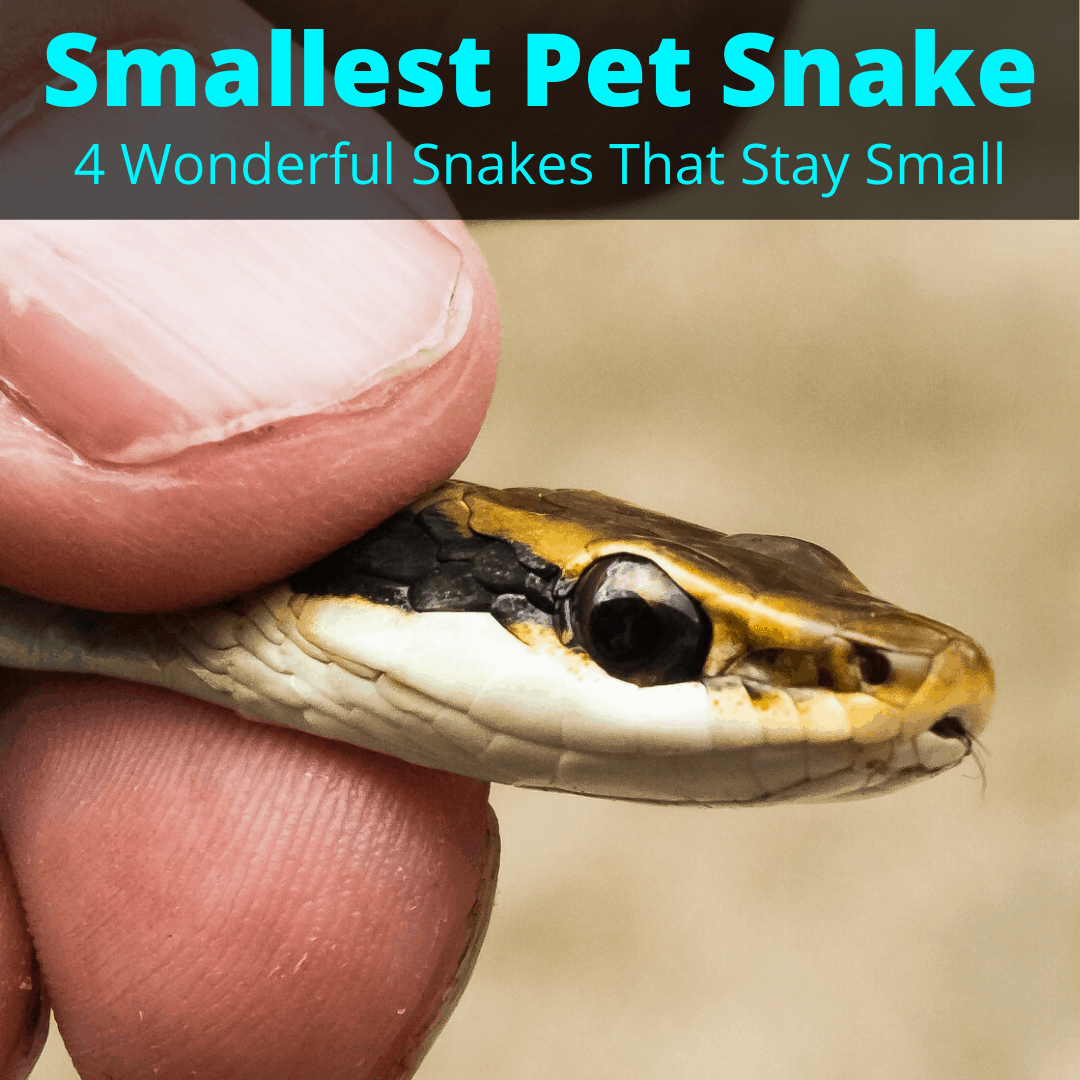
What do you do? Just get a hamster?
What if I told you you could keep a snake in the space of a hamster?
There are actually a lot of snakes out there that stay fairly small, never growing longer than 5 feet.
These snakes still take up more space than a hamster, but if you have a little more space, then they make great pets.
Snakes that measure below five feet, including the garter snake, rosy boa, Mexican milk snake, African egg-eating snake, and western hognose snake.
But 5 feet is still pretty big. If you really don’t have the space for anything more than a hamster cage, we’ll have to get even smaller.
Table of Contents
4 Smallest Pet Snakes That Stay Small
There are snakes that range from truly tiny to a maximum of 2 to 3 feet in length. These are perfect when you’re pressed for space. Here are four of the best small snakes to keep as pets:
- Brahminy snake (blind snake)
- Ringneck Snake
- Kenyan Sand Boa
- Children’s python
None of these snakes grows over 3 feet in length or needs an enclosure that is larger than 20 gallons.
The Brahminy Snake
When you only have space for an earthworm but want a snake.
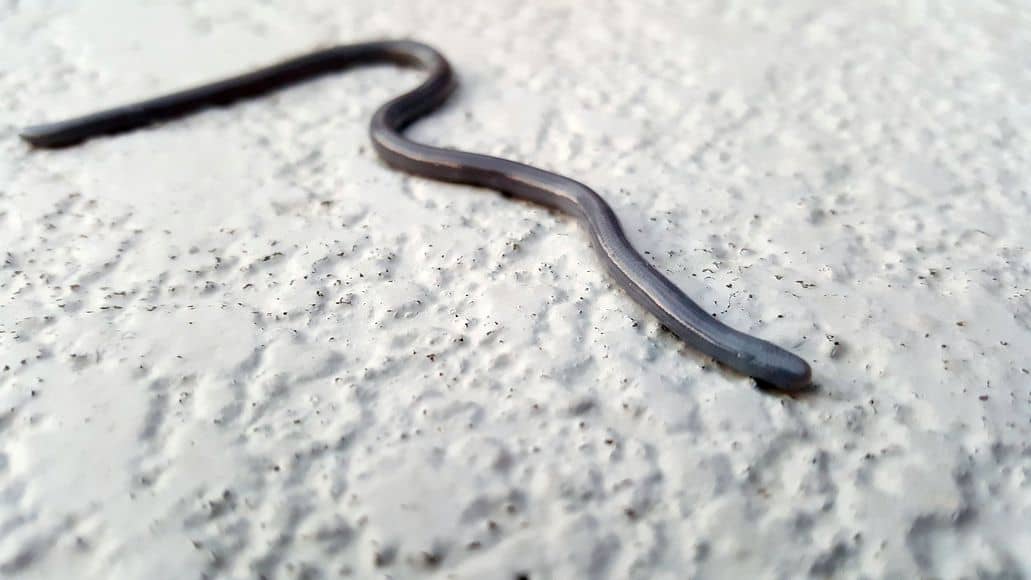
Forget the hamster, what if you only have space for an earthworm? Don’t worry, you won’t have to get a worm as a pet, thanks to the Brahminy Snake.
Also called the flowerpot snake, the Brahminy snake (Ramphotyphlops braminus) is the most common of the snakes that look like worms.
It is also quite an uncommon pet. These snakes so small they are sometimes confused with a large earthworm.
Only 2.5 to 6 inches in length when fully grown, this tropical snake is originally from Asia but has spread to parts of Africa, India, Sri Lanka, some of the Pacific Islands, Australia, and Mexico. In the USA it is found in Florida and Texas.
The blind snakes are part of the superfamily Typhlopidea consisting of the families Anomalepidae, Leptotyphlopidae, and Typhlopidae. The Brahminy snake is thought to be a parthenogenic species — all the members of the species are female and reproduction takes place without mating.
Brahminy Appearance
The Brahminy snake’s degenerate eyes are hidden beneath opaque head scales on its small, blunt head. It has a cylindrical body and a short tail. The snake’s body is smooth with shiny scales.
All the blind snakes are fossorial, i.e. living subterraneously and burrowing and they are often associated with ant and termite nests.
Brahminy Snake Diet
Brahminy snakes naturally feed on eggs and the larvae of termites and ants, as well as other soft-bodied anthropods like mites, centipedes, millipedes, other insects, and eggs.
When you keep your snake in captivity, you can feed them termites and ants, as well as other small insects that can be left inside the enclosure.
Brahminy Snake Enclosure
Because the Brahminy snake is a tropical snake, aim for temperatures around 75° to 85° F. Use a substrate like potting soil to give it something to burrow into.
You can place a small hide on top of the soil, although your snake may not use it all that often, preferring the safety of the soil. They are completely harmless and you can handle your Brahminy snake if you want to.
The size of the enclosure of your snake can be as small as a gallon jar, which makes it the perfect pet if you really don’t have space for another snake enclosure. The ideal enclosure would be something like this.
If you want to decorate the enclosure, don’t go for rocks — the last thing you want is your poor snake being crushed if it burrows too close to the rocks!
Should A Brahminy Snake Be Your New Pet?
The Brahminy snake has a lot going for it — cuteness, size, low maintenance, and if you’re too squeamish to feed your snake rodents, this may just be the snake for you. However, it is hardly the most interesting of snake companions as it spends most of its time hiding under the ground.
If you’re looking for something bigger, but still small, the ringneck snake is a great option.
The Ringneck Snake
They’re harmless, but don’t look it.
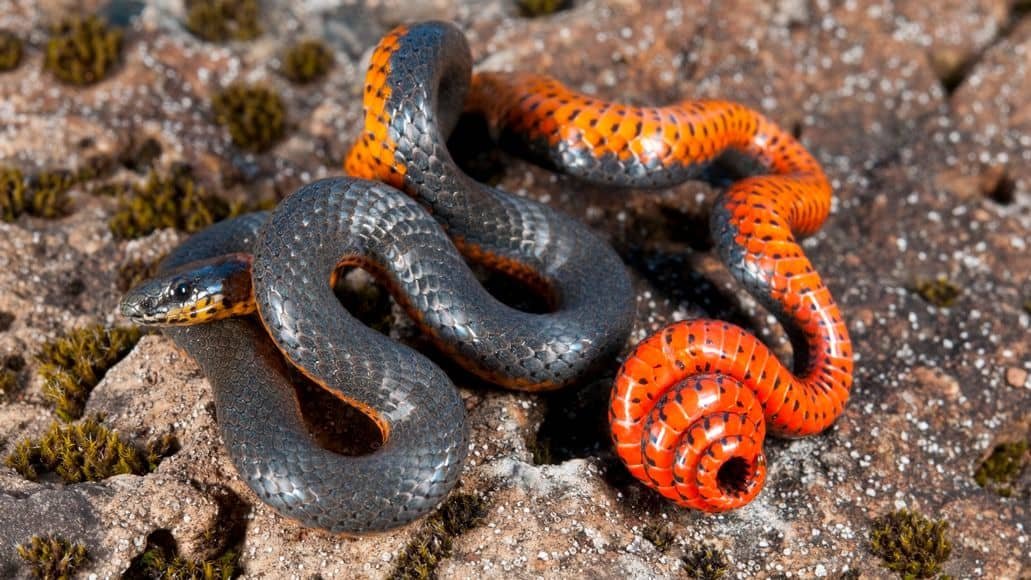
The ringneck snake (Diadophis punctatus) is a harmless colubrid snake of the US, Central Mexico and southeastern Canada that grows to be about 10 to 15 inches long. It has two subspecies: the northern ringneck snake (Diodophis punctatus edwardsi) and the southern ringneck snake (Diadophus punctatus punctatus).
They spend most of their time underground or hidden beneath logs or leaf litter. Ringneck snakes are harmless to humans but have weak venom in their saliva which they use to subdue their prey. Their prey ranges from amphibians, lizards and small snakes to salamanders and invertebrates.
Ringneck Snake Appearance
The ringneck is a slender snake that is grayish (but can vary from black to tan) in color, with a yellow or orange ring around the neck. They also have a yellow or orange underside.
The northern ringneck snake prefers mountainous regions and is larger than its southern cousin. The neckring of the northern ringneck snake is also complete and it has no pattern on its underside.
The southern ringneck snake prefers the coastal plains, has a broken neck ring and its underside is marked with a single line or row of black spots.
Ringneck Snake Diet
As stated above, ringnecks eat anything from amphibians to reptiles and other small snakes. However, when you keep one (or more) in captivity, you can feed them nightcrawlers, crickets, insects and even earthworms, depending on their size.
A calcium supplement may be added to your snake’s diet, but it is best to consult with your vet before giving any supplements.
Ringneck Snake Enclosures
As ringneck snakes rarely grow beyond 15 inches long, a 10-gallon enclosure would be large enough to house one comfortably.
These snakes will thrive with minimal setup. Spend your money on getting a good substrate for your ringneck, rather than go all out with the decorating.
A substrate of sand, peat moss, and dead leaves is perfect for them to burrow into and hide in. Do NOT use cedar shavings, though.
The tank should be misted daily to ensure that the moss stays moist, but do not keep the whole tank moist as this could lead to your snake getting skin infections. You must also provide a shallow water bowl with fresh water.
Unfortunately, these snakes are absolutely wonderful escape artists. Various sources agree that, instead of just using the clips your snake enclosure comes with for the top of the enclosure, you should get additional clips.
These Zilla clips work well.
Using additional clips ensures that the lid is really tight-fitting and your ringneck can’t find a crack through which to slither out.
The temperature inside the snake enclosure should be an ambient temperature of 72° to 76° F, with the basking temperature being 82° F.
https://www.youtube.com/watch?v=7jp1nrwiiuk
Should A Ringneck Snake Be Your New Pet?
As with the Brahminy snake, the ringneck is a low-maintenance pet, although this one does take up a bit more space! It is still a burrowing snake that likes to hide, but it is not only easier to feed, it is also easier to handle as it is larger.
The ringneck is also completely harmless to humans, which is another good thing if you like the idea of having a snake, but really don’t need a venomous one in your life.
However, the snake is still very small and will need to be fed with a lot of care to make sure that it gets enough sustenance. If you are squeamish about feeding your snake rodents, however, this insect-eating species may just be the one for you.
The third snake we’ll be looking at is the Kenyan sand boa — a snake almost twice the size of the ringneck snake.
The Kenyan Sand Boa
Truly Out of Africa.
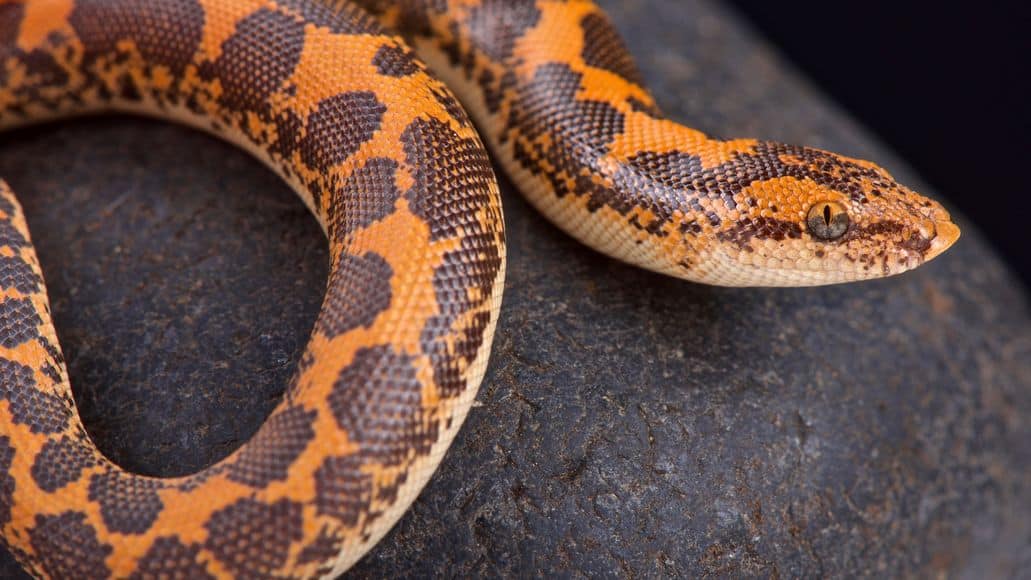
The Kenyan sand boa (Eryx colubrinus), also sometimes called the East African sand boa, is native to northern Kenya and has become a firm favorite among herpetologists.
Kenyan Sand Boa Appearance
Kenyan sand boa males rarely exceed 20 inches in length, with the females reaching just over 2 feet. It has a heavy, stout body and comes in various color morphs including albino, snow, paradox, tiger, striped, etc.
They don’t often bite, but, if they do, the bite is hardly more than a scratch. They are, for all intents and purposes, completely harmless to humans.
Kenyan Sand Boa Diet
Kenyan sand boas have quite good appetites — and strong appetites for live food when they are still babies. When it is still a baby, it should be fed pinky mice, switching to thawed mice as it matures.
As adults, males can be fed large hopper mice every 10 to 14 days and females a jumbo-sized mouse every week.
Offer the food with 15-inch metal tweezers, because even thawed food will get constricted before being eaten. When your Kenyan sand boa is about to shed, it will refuse food.
Kenyan Sand Boa Enclosure
Because of their diminutive size, even the largest of the Kenyan sand boas can be kept in a 10-gallon enclosure.
The enclosure needs to be kept quite warm — an ambient temperature of approximately 80° F, with the basking spot being about 95° F. The temperature can fall to the mid-70s during the night, however.
Keep the accessories in your Kenyan sand boa snake enclosure to a minimum. As with the other small snakes mentioned in this article, don’t use heave rocks, because they can fall on your pet and severely injure it.
Some Kenyan sand boas love to climb, so it is a good idea to add some snake branches to the enclosure even though the boas spend quite a bit of time underground as well.
These Kenyan sand boas are also quite the escape artists, so make sure that there are no gaps through which they can slither. Ensure that the top of the enclosure is truly tight-fitting by adding some extra clips. This also ensures that the top of the enclosure cannot be pushed away.
When it comes to the substrate, you are spoiled for choice: sand, aspen bedding, coconut mulch, play sand, and even newspaper. However, as with other snakes, do NOT use cedar shavings.
You can read all about the different bedding types in our rundown of the best substrates for snakes. For the Kenyan Sand Boa, aspen bedding is best.
Be sure to keep fresh water available at all times as well.
If your Kenyan sand boa is shedding, it needs high humidity in the enclosure, so make sure that you keep an eye out for that.
Should A Kenyan Sand Boa Be Your New Pet?
The Kenyan sand boa is a truly long-term commitment, as there are reports of some living for more than 30 years and many living to be over 20. However, they are a lot more interactive — and active — than a Brahminy snake or a ringneck snake.
They are still quite low-maintenance pets and as long as their enclosure is kept at the right temperature and they’re fed, they’re quite happy. However, they are still small snakes when compared to something like a corn snake, so if you’re looking for a large snake to display in a snake enclosure, a Kenyan snake boa is not the snake for you.
The final snake we’ll be looking at in this article is the Children’s python.
The Children’s Python
A veritable behemoth — in the world of small snakes.

The Children’s python is a beautiful specimen from Australia. Named after John George Children, the Antaresia childreni, from the family Pythonidae and order Squamata, actually consists of four related species.
These species are the Children’s python, spotted python, anthill python (the smallest python in the world) and the large-blotched or Stimson’s python. The Children’s pythons is the only one commonly kept as a pet around the world.
Children’s Python Appearance
Generally of a calm demeanor (although hatchlings may be more defensive until they get used to you) the Children’s python is not a heavy-bodied snake as some of the other pythons. It is an active snake, though. Measuring in at 2.5 feet, it is the second smallest python in the world.
The Children’s python is a brown snake with darker brown spots in five or six longitudinal series. The underside of the Children’s python is yellowish in color but does not have any markings. You can see a rainbow sheen when the snake is exposed to direct light at the right angle, similar to the rainbow boa.
Children’s Python Diet
Your Children’s python hatchling or baby’s diet is not for the squeamish, as they should preferably be fed 2 to 3 live pinky mice per week. If your snake doesn’t seem keen on its food, you can scent it with a lizard, like a house gecko.
Adults should be fed thawed mice that are one to one-and-a-half times the diameter of the snake at its thickest point. Of these, your python should eat about 2 per week.
Your Children’s python will also fast before shedding like other snakes.
Children’s Python Enclosure
The size of the enclosure for a Children’s python should be about 20 gallons, like this one:
A low wattage heat mat on the bottom of a part of your snake’s enclosure will provide the temperature gradient that they need. The inside surface, just above the mat, should measure 85° F to 95° F.
You should provide two hides for your snake — one on the cooler side of the enclosure and one on the warm side of the enclosure. Add a branch to the enclosure as well, because Children’s pythons sometimes climb trees.
You don’t really have to bother with other lights for your Children’s python — the room lights and normal daylight should be enough. Remember that your Children’s python is a nocturnal creature, so if you don’t really see it during the day, don’t stress.
The substrate for your Children’s python should be at least 1″ deep and fresh water should always be available. You can choose from the various substrates available, although sand is a good idea. As with other snakes, cedar is a huge no-no.
Should A Children’s Python Be Your New Pet?
If you’re looking for a small snake to keep as a pet but also don’t want to go as small as a ringneck, the Children’s python may just be for you. The commitment to your Children’s python will be a long-term one, however, as they live to be over 20 in captivity.
That said, they are easy to accommodate and their enclosure need not take up too much space. And, of course, they are absolutely beautiful! You can’t be squeamish when it comes to feeding, though. The thawed mice may be all good, but remember that they eat live pinkies when they are babies!
Smallest Pet Snakes: Final Thoughts
Most snakes grow fairly large, so if you want a small pet snake that stays small, your options are a bit limited. That said, the options you do have are all pretty cool.
You can go miniature with the Brahminy, though I don’t find this snake all that exciting. If you can spare a little more space, I’d recommend any of the other three options. They are a lot more fun to keep as a pet!



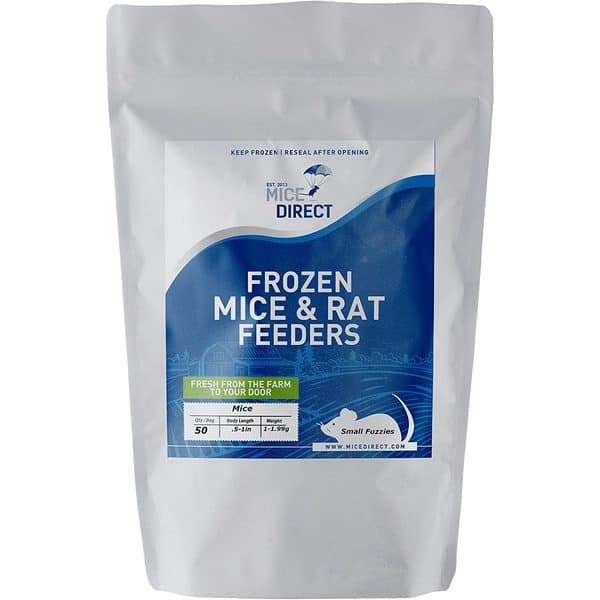


Leave a Reply